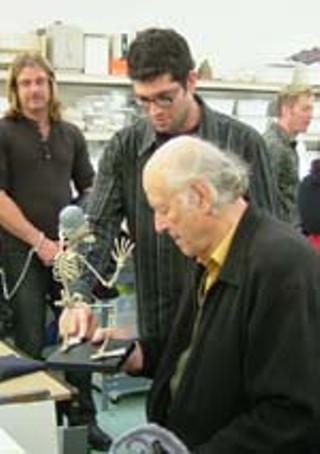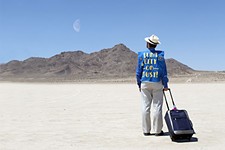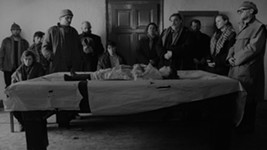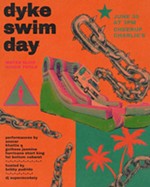Irreplaceable
Co-Director Mike Johnson on 'Tim Burton's Corpse Bride' and how stop-motion has done more than survive amid the rise of computer animation
By Spencer Parsons, Fri., Sept. 23, 2005

In Tim Burton's Corpse Bride, a maggot lives in the heroine's head offering advice like some twisted, Peter Lorre-voiced Jiminy Cricket. It's a great gag, somewhat feral and perfectly in tune with the folktale origins of the story in what must be the most technically sophisticated stop-motion puppet feature ever and very likely the most narratively ambitious, to boot. Was it a similarly improbable conscience that guided former Austinite Mike Johnson to make a living bringing puppets to life? "I never considered it a career option," Tim Burton's co-director on the new film tells me. "I mean, I hardly realized that anyone still did it."
As all things Pixar and Shrek induce studios and audiences to believe computers invented animation, it seems all too appropriate that the state of the art in stop-motion concerns dead folks with more verve than the living. A story of confused, young Victor caught between two brides, the living Victoria and the dead Corpse Bride (voiced by Johnny Depp, Emily Watson, and Helena Bonham Carter, respectively), the film's deceptively simple plot traverses the complex emotional landscape of a tragic love triangle without villains (not the sort of thing most animated films even try). For Johnson, co-directing obviously marks a big step up from being rigging assistant on Tim Burton's The Nightmare Before Christmas, but then it's actually a big step for all involved. I managed to catch him on his way out the door to the Hollywood premiere to discuss the film's technology, its influences, and the Peter Lorre connection.
Austin Chronicle: Disney recently shut down its cell-animation unit, and puppet animation is uncommon to begin with. So how does it feel to be doing this sort of quaint, handmade thing these days?
Mike Johnson: I feel really fortunate to have the opportunity to do this, because there aren't many who do it, and the opportunities come around so rarely. There especially aren't many people who do it on this scale. It really takes someone like Tim Burton, who has the clout and the passion to make it happen. It's great working with Tim, just an incredible experience, and he just has a real love for the art form and a really uncompromising vision for what he wants to see up there. So he kind of created this safe space for me to work with these animators and these artists to do this.
AC: And was that what allowed you to make technical innovations, like shooting the movie on digital stills?
MJ: That really saved us, actually. We had these Mitchell cameras, which we'd used on Nightmare. And you know these cameras were built in the Thirties – they're the same ones from King Kong, actually – and they're tried and true, but I was concerned that with our schedule as tight as it was, the turnaround on film dailies was going to kill us. When Warner Bros. let us go with digital, we could get a shot and then see what we'd done in the same day. It really gave us a lot more time to rehearse and block shots, and I think that helped give us this much more refined feel to the animation.
AC: And what about the puppets themselves?
MJ: Well, we did have these gear mechanisms about the size of a walnut inside the heads that would allow us to move the mouths and alter facial expressions without having to replace the whole face, like we used to do. That was really the biggest innovation as far as the puppet design goes. At first, there was a big push toward the replacement technique just because it was, you know, "how it's done." My concern was with these more human characters and the subtle shading on their faces and the subtle expressions we'd have to get out of them, that replacement wouldn't hold up, and we'd be more limited in what we could have them do and how we could light them ...
So the puppets ended up being about 18 inches tall, bigger than we thought going in. And then the sets had to be bigger, and everything became bigger. But that was a real plus because I think that you get a better sense of scale and perspective. We really managed to get away from the usual tabletop feel and got into a wider world for the characters to move around in.

AC: Of course, it also has this classic feel to it, and you make an explicit nod to Ray Harryhausen, for instance.
MJ: Yeah, I was a big, big monster movie fan, always catching glimpses of that kind of stuff on creature double feature or whatever the late-night television show would be, sometimes just catching glimpses of these movies, out of context, a scene from a Harryhausen film here or there caught in passing. And in a way, it gave it a more surreal, dreamlike quality. So absolutely. Of course. I love those movies ... Peter Lorre Jr. actually hosted one of those shows in Austin. He looked and sounded exactly like his father, and he actually lived down the street from my family. We never really knew him, but he'd throw a big Halloween party and that sort of thing, so it's kind of cool to have a character in the movie that refers to that.
AC: Corpse Bride has a great cast of skeletons, who can do a few tricks the ones from Jason and the Argonauts could never do.
MJ: Yeah, I think that's one of the tools that we had that Ray Harryhausen never had. You know, he would have to hang it on invisible threads, super-thin wires, floated there frame by frame, which he did in a lot of films. But for us, we could put the puppets on rods and rigs that would be easier to manipulate, and then we could digitally remove those rigs later, which really gave us some flexibility. You know, it's interesting, because people thought computers and technology would kill stop-motion animation, but actually it's bringing it forward.
AC: But it's more than technical, because this one's different in tone. It's a full-on romance, which there's not much of a tradition for in this medium.
MJ: Well, you know, most animated films are marketed as children's movies that adults will also like, and we wanted to make a film for adults that children would like. So, we wanted it to work as a drama and as a love story and also get all the great stuff that you get in an animated film. So we needed characters that you could believe would have this love triangle between them and would work on a level beyond cartoon characters. And the voices were a huge part in that. We were fortunate to get such fantastic actors. That really took everything up a notch. For me, it really starts with the character.
AC: Yeah, like, I'm really into the dog. The dog is great. That's not a question, really. Just ... is there anything you have to say about the dog?
MJ: Yeah, I like him a lot, too. Our animation supervisor, Anthony Scott, was the one who really set the style, because he has this little yappy dog and, actually, the voice is his dog. So he was really very close to it and channeling something through it. But you know, we had the freedom to do whatever we wanted to some degree, working within this vision Tim had set forward. At some points we just came up with visual gags we wanted to see in the film and we would just create characters to support that. Like a lot of the background characters in the Land of the Dead and things like that. That's really what gets me going about it, just the physicality of these puppets, making them into characters.
There's one, Finis, Victoria's father, who's voiced by Albert Finney. He's really my favorite. All the elements really jelled with him. In Tim's initial sketch, the heart of the character was there, and then from the refined design and the voice ... there were never any hesitant steps with him. I love seeing him move and speak.
There was this one shot, though, when he meets the other parents, and we came up with this really funny grin that's perfect for the shape of his face, but we just couldn't quite get it, so we sculpted a one-off head just for that.
AC: So the new technology's nice and all, but you've got to do what's necessary to get the smile right ...
MJ: You know, everyone on it was so obsessed, really, and Tim shared that obsession, and kind of allowed us all to indulge our obsession, and I'm really glad if that shows on the screen. ![]()
Tim Burton's Corpse Bride opens in Austin on Friday, Sept. 23. For a review and show times, see Film Listings.










